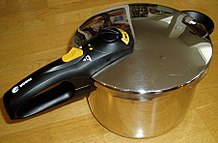
A pressure cooker is a sealed vessel for cooking food with the use of high pressure steam and water or a water-based liquid, a process called pressure cooking. The high pressure limits boiling and creates higher temperatures not possible at lower pressures, allowing food to be cooked faster than at normal pressure.
The prototype of the modern pressure cooker was the steam digester invented in the seventeenth century by the physicist Denis Papin. It works by expelling air from the vessel and trapping steam produced from the boiling liquid. This is used to raise the internal pressure up to one atmosphere above ambient and gives higher cooking temperatures between 100–121 °C (212–250 °F). Together with high thermal heat transfer from steam it permits cooking in between a half and a quarter the time of conventional boiling as well as saving considerable energy.
Almost any food that can be cooked in steam or water-based liquids can be cooked in a pressure cooker.[1] Modern pressure cookers have many safety features to prevent the pressure cooker from holding too much pressure causing an explosion. After cooking, the steam pressure is lowered back to ambient atmospheric pressure so that the vessel can be opened. On all modern devices, a safety lock prevents opening while under pressure.
According to the New York Times Magazine, 37% of U.S. households owned at least one pressure cooker in 1950. By 2011, that rate dropped to only 20%. Part of the decline has been attributed to fear of explosion (although this is extremely rare with modern pressure cookers) along with competition from other fast cooking devices such as the microwave oven.[2] However, third-generation pressure cookers have many more safety features and digital temperature control, do not vent steam during cooking, and are quieter and more efficient, and these conveniences have helped make pressure cooking more popular.[3]
- ^ Cite error: The named reference
brevwas invoked but never defined (see the help page). - ^ ROB MIFSUD (February 29, 2012). "A Pot With Benefits--How the pressure cooker fell out of favor, and why it's time to bring it back". The Slate Group. Retrieved September 6, 2020.
- ^ "The Instant Pot Will Not Solve All of Life's Problems". The Atlantic. 8 January 2019.